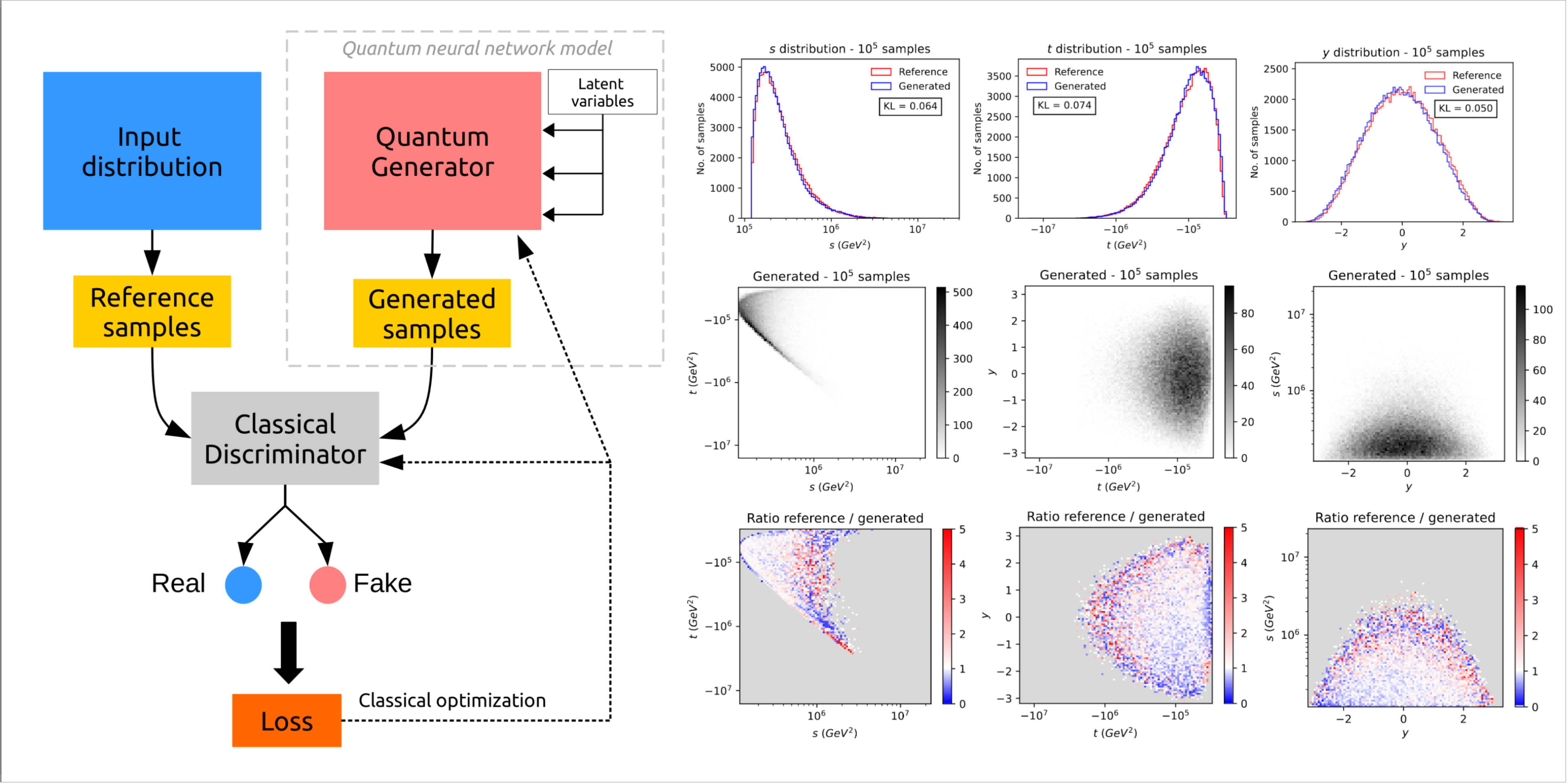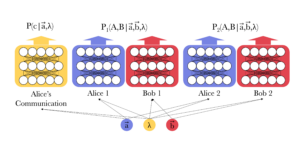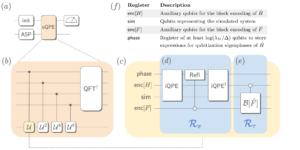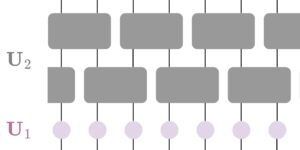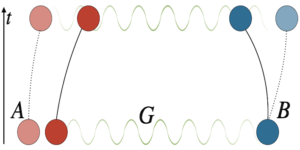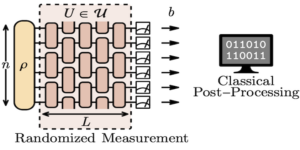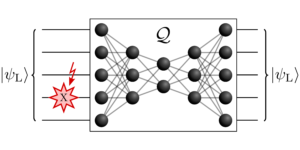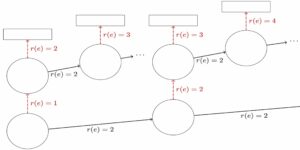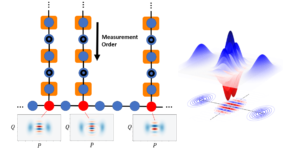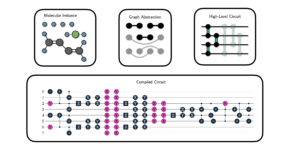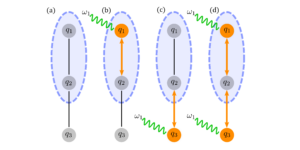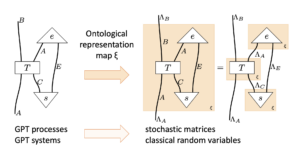1Quantum Research Centre, Technology Innovation Institute, Abu Dhabi, Emirati Arabi Uniti
2Departament de Física Quàntica i Astrofísica e Institut de Ciències del Cosmos (ICCUB), Universitat de Barcelona, Barcellona, Spagna.
3Dipartimento di Fisica Teorica, CERN, CH-1211 Ginevra 23, Svizzera.
4Istituto di Fisica, Università Nazionale Yang Ming Chiao Tung, Hsinchu 30010, Taiwan.
5TIF Lab, Dipartimento di Fisica, Università degli Studi di Milano e INFN Sezione di Milano, Milano, Italia.
Trovi questo documento interessante o vuoi discuterne? Scrivi o lascia un commento su SciRate.
Astratto
Proponiamo e valutiamo un'architettura quantistica alternativa nel contesto dell'apprendimento generativo contraddittorio per la generazione di eventi Monte Carlo, utilizzata per simulare i processi di fisica delle particelle al Large Hadron Collider (LHC). Convalidiamo questa metodologia implementando la rete quantistica su dati artificiali generati da distribuzioni sottostanti note. La rete viene quindi applicata ai set di dati generati da Monte Carlo di specifici processi di scattering di LHC. La nuova architettura del generatore quantistico porta a una generalizzazione delle implementazioni allo stato dell'arte, ottenendo divergenze Kullback-Leibler minori anche con reti poco profonde. Inoltre, il generatore quantistico apprende con successo le funzioni di distribuzione sottostanti anche se addestrato con piccoli insiemi di campioni di addestramento; questo è particolarmente interessante per le applicazioni di aumento dei dati. Distribuiamo questa nuova metodologia su due diverse architetture hardware quantistiche, tecnologie a ioni intrappolati e superconduttori, per testarne la fattibilità indipendente dall'hardware.
Immagine di presentazione: a sinistra, passaggi schematici coinvolti nella formazione style-qGAN. A destra, distribuzioni di campioni marginali per le osservabili fisiche, s, t, y in pp -> produzione ttbar all'LHC per il modello style-qGAN.
► dati BibTeX
► Riferimenti
, J. Preskill, Quantum 2, 79 (2018).
https://doi.org/10.22331/q-2018-08-06-79
, F. Arute, K. Arya, R. Babbush, D. Bacon, JC Bardin, R. Barends, R. Biswas, S. Boixo, FGSL Brandao, DA Buell, et al., Nature 574, 505 (2019).
https://doi.org/10.1038/s41586-019-1666-5
, H.-S. Zhong, H. Wang, Y.-H. Deng, M.‑C. Chen, L.‑C. Peng, Y.‑H. Luo, J. Qin, D. Wu, X. Ding, Y. Hu, et al., Science 370, 1460 (2020).
https: / / doi.org/ 10.1126 / science.abe8770
, M. Cerezo, A. Arrasmith, R. Babbush, SC Benjamin, S. Endo, K. Fujii, JR McClean, K. Mitarai, X. Yuan, L. Cincio, et al., Nature Reviews Physics 3, 625–644 (2021).
https://doi.org/10.1038/s42254-021-00348-9
, K. Bharti, A. Cervera-Lierta, TH Kyaw, T. Haug, S. Alperin-Lea, A. Anand, M. Degroote, H. Heimonen, JS Kottmann, T. Menke, W.-K. Mok, S.Sim, L.‑C. Kwek e A. Aspuru-Guzik, Reviews of Modern Physics 94, 015004 (2022).
https: / / doi.org/ 10.1103 / RevModPhys.94.015004
, J. Biamonte, P. Wittek, N. Pancotti, P. Rebentrost, N. Wiebe e S. Lloyd, Nature 549, 195 (2017).
https: / / doi.org/ 10.1038 / nature23474
, M. Schuld e F. Petruccione, Apprendimento supervisionato con computer quantistici, vol. 17 (Primavera, 2018).
https://doi.org/10.1007/978-3-319-96424-9
, N. Wiebe, D. Braun e S. Lloyd, Physical Review Letters 109, 050505 (2012).
https: / / doi.org/ 10.1103 / PhysRevLett.109.050505
, S. Lloyd, M. Mohseni e P. Rebentrost, arXiv preprint arXiv:1307.0411 (2013).
https:///doi.org/10.48550/arXiv.1307.0411
arXiv: 1307.0411
, P. Rebentrost, M. Mohseni e S. Lloyd, Physical Review Letters 113, 130503 (2014).
https: / / doi.org/ 10.1103 / physrevlett.113.130503
, I. Kerenidis e A. Prakash, Physical Review A 101, 022316 (2020).
https: / / doi.org/ 10.1103 / PhysRevA.101.022316
, AW Harrow, A. Hassidim e S. Lloyd, Physical Review Letters 103, 150502 (2009).
https: / / doi.org/ 10.1103 / PhysRevLett.103.150502
, M. Benedetti, E. Lloyd, S. Sack e M. Fiorentini, Quantum Science and Technology 4, 043001 (2019a).
https://doi.org/10.1088/2058-9565/ab4eb5
, S. Sim, PD Johnson e A. Aspuru-Guzik, Advanced Quantum Technologies 2, 1900070 (2019).
https: / / doi.org/ 10.1002 / qute.201900070
, C. Bravo-Prieto, J. Lumbreras-Zarapico, L. Tagliacozzo, e JI Latorre, Quantum 4, 272 (2020).
https://doi.org/10.22331/q-2020-05-28-272
, M. Larocca, N. Ju, D. García-Martín, PJ Coles e M. Cerezo, arXiv preprint arXiv:2109.11676 (2021).
https:///doi.org/10.48550/arXiv.2109.11676
arXiv: 2109.11676
, M. Schuld, R. Sweke e JJ Meyer, Physical Review A 103, 032430 (2021).
https: / / doi.org/ 10.1103 / PhysRevA.103.032430
, T. Goto, QH Tran e K. Nakajima, Physical Review Letters 127, 090506 (2021).
https: / / doi.org/ 10.1103 / PhysRevLett.127.090506
, A. Pérez-Salinas, D. López-Núñez, A. García-Sáez, P. Forn-Díaz e JI Latorre, Physical Review A 104, 012405 (2021).
https: / / doi.org/ 10.1103 / PhysRevA.104.012405
, V. Havlíček, AD Córcoles, K. Temme, AW Harrow, A. Kandala, JM Chow e JM Gambetta, Nature 567, 209 (2019).
https://doi.org/10.1038/s41586-019-0980-2
, M. Schuld, A. Bocharov, KM Svore e N. Wiebe, Physical Review A 101, 032308 (2020).
https: / / doi.org/ 10.1103 / physreva.101.032308
, A. Pérez-Salinas, A. Cervera-Lierta, E. Gil-Fuster e JI Latorre, Quantum 4, 226 (2020).
https://doi.org/10.22331/q-2020-02-06-226
, T. Dutta, A. Pérez-Salinas, JPS Cheng, JI Latorre e M. Mukherjee, Physical Review A 106, 012411 (2022).
https: / / doi.org/ 10.1103 / PhysRevA.106.012411
, J. Romero, JP Olson e A. Aspuru-Guzik, Quantum Science and Technology 2, 045001 (2017).
https: / / doi.org/ 10.1088 / 2058-9565 / aa8072
, A. Pepper, N. Tischler e GJ Pryde, Physical Review Letters 122, 060501 (2019).
https: / / doi.org/ 10.1103 / PhysRevLett.122.060501
, C. Bravo-Prieto, Apprendimento automatico: scienza e tecnologia 2, 035028 (2021).
https:///doi.org/10.1088/2632-2153/ac0616
, C. Cao e X. Wang, Physical Review Applied 15, 054012 (2021).
https: / / doi.org/ 10.1103 / PhysRevApplied.15.054012
, M. Benedetti, D. Garcia-Pintos, O. Perdomo, V. Leyton-Ortega, Y. Nam e A. Perdomo-Ortiz, npj Quantum Information 5, 1 (2019b).
https://doi.org/10.1038/s41534-019-0157-8
, KE Hamilton, EF Dumitrescu e RC Pooser, Physical Review A 99, 062323 (2019).
https: / / doi.org/ 10.1103 / PhysRevA.99.062323
, B. Coyle, D. Mills, V. Danos ed E. Kashefi, npj Quantum Information 6, 1 (2020).
https://doi.org/10.1038/s41534-020-00288-9
, P.-L. Dallaire-Demers e N. Killoran, Physical Review A 98, 012324 (2018).
https: / / doi.org/ 10.1103 / PhysRevA.98.012324
, S. Lloyd e C. Weedbrook, Physical Review Letters 121, 040502 (2018).
https: / / doi.org/ 10.1103 / PhysRevLett.121.040502
, I. Goodfellow, J. Pouget-Abadie, M. Mirza, B. Xu, D. Warde-Farley, S. Ozair, A. Courville e Y. Bengio, Communications of the ACM 63, 139–144 (2020).
https: / / doi.org/ 10.1145 / 3422622 mila
, C. Zoufal, A. Lucchi e S. Woerner, npj Quantum Information 5, 1 (2019).
https://doi.org/10.1038/s41534-019-0223-2
, J. Zeng, Y. Wu, J.-G. Liu, L. Wang e J. Hu, Physical Review A 99, 052306 (2019).
https: / / doi.org/ 10.1103 / PhysRevA.99.052306
, H. Situ, Z. He, Y. Wang, L. Li e S. Zheng, Scienze dell'informazione 538, 193 (2020).
https:///doi.org/10.1016/j.ins.2020.05.127
, L. Hu, S.‑H. Wu, W. Cai, Y. Ma, X. Mu, Y. Xu, H. Wang, Y. Song, D.-L. Deng, C.‑L. Zou, et al., Science Advances 5, eaav2761 (2019).
https: / / doi.org/ 10.1126 / sciadv.aav2761
, M. Benedetti, E. Grant, L. Wossnig e S. Severini, New Journal of Physics 21, 043023 (2019c).
https://doi.org/10.1088/1367-2630/ab14b5
, J. Romero e A. Aspuru-Guzik, Advanced Quantum Technologies 4, 2000003 (2021).
https: / / doi.org/ 10.1002 / qute.202000003
, MY Niu, A. Zlokapa, M. Broughton, S. Boixo, M. Mohseni, V. Smelyanskyi e H. Neven, Physical Review Letters 128, 220505 (2022).
https: / / doi.org/ 10.1103 / PhysRevLett.128.220505
, T. Karras, S. Laine e T. Aila, IEEE Transactions on Pattern Analysis and Machine Intelligence 43, 4217 (2021).
https: / / doi.org/ 10.1109 / TPAMI.2020.2970919
, A. Pérez-Salinas, J. Cruz-Martinez, AA Alhajri e S. Carrazza, Physical Review D 103, 034027 (2021).
https: / / doi.org/ 10.1103 / PhysRevD.103.034027
, W. Guan, G. Perdue, A. Pesah, M. Schuld, K. Terashi, S. Vallecorsa e J.‑R. Vlimant, Apprendimento automatico: scienza e tecnologia 2, 011003 (2021).
https:///doi.org/10.1088/2632-2153/abc17d
, SY Chang, S. Vallecorsa, EF Combarro e F. Carminati, arXiv preprint arXiv:2101.11132 (2021a).
https:///doi.org/10.48550/arXiv.2101.11132
arXiv: 2101.11132
, SY Chang, S. Herbert, S. Vallecorsa, EF Combarro e R. Duncan, EPJ Web of Conferences 251, 03050 (2021b).
https:///doi.org/10.1051/epjconf/202125103050
, V. Belis, S. González-Castillo, C. Reissel, S. Vallecorsa, EF Combarro, G. Dissertori e F. Reiter, EPJ Web of Conferences 251, 03070 (2021).
https:///doi.org/10.1051/epjconf/202125103070
, GR Khattak, S. Vallecorsa, F. Carminati e GM Khan, The European Physical Journal C 82, 1 (2022).
https://doi.org/10.1140/epjc/s10052-022-10258-4
, P. Baldi, L. Blecher, A. Butter, J. Collado, JN Howard, F. Keilbach, T. Plehn, G. Kasieczka e D. Whiteson, arXiv preprint arXiv:2012.11944 (2021).
https:///doi.org/10.48550/arXiv.2012.11944
arXiv: 2012.11944
, M. Backes, A. Butter, T. Plehn e R. Winterhalder, SciPost Physics 10, 89 (2021).
https: / / doi.org/ 10.21468 mila / SciPostPhys.10.4.089
, A. Butter e T. Plehn, in Artificial Intelligence For High Energy Physics (World Scientific, 2022) pp. 191–240.
https: / / doi.org/ 10.1142 / 9789811234033_0007
, A. Butter, S. Diefenbacher, G. Kasieczka, B. Nachman e T. Plehn, SciPost Physics 10, 139 (2021).
https: / / doi.org/ 10.21468 mila / SciPostPhys.10.6.139
, A. Butter, T. Plehn e R. Winterhalder, SciPost Physics Core 3, 9 (2020).
https:///doi.org/10.21468/SciPostPhysCore.3.2.009
, M. Bellagente, A. Butter, G. Kasieczka, T. Plehn e R. Winterhalder, SciPost Physics 8, 70 (2020).
https: / / doi.org/ 10.21468 mila / SciPostPhys.8.4.070
, A. Butter, T. Plehn e R. Winterhalder, SciPost Physics 7, 75 (2019).
https: / / doi.org/ 10.21468 mila / SciPostPhys.7.6.075
, S. Efthymiou, S. Ramos-Calderer, C. Bravo-Prieto, A. Pérez-Salinas, D. García-Martín, A. Garcia-Saez, JI Latorre e S. Carrazza, Quantum Science and Technology 7, 015018 ( 2021a).
https://doi.org/10.1088/2058-9565/ac39f5
, S. Efthymiou, S. Carrazza, S. Ramos, bpcarlos, AdrianPerezSalinas, D. García-Martín, Paul, J. Serrano, e atomicprinter, qiboteam/qibo: Qibo 0.1.6-rc1 (2021b).
https: / / doi.org/ 10.5281 / zenodo.5088103
, M. Abadi, A. Agarwal, P. Barham, E. Brevdo, Z. Chen, C. Citro, GS Corrado, A. Davis, J. Dean, M. Devin, et al., TensorFlow: machine learning su larga scala su sistemi eterogenei (2015), software disponibile su tensorflow.org.
https:///www.tensorflow.org/
, afrancis heplat, C. Bravo-Prieto, S. Carrazza, M. Cè, J. Baglio, e dm grabowska, Qti-th/style-qgan: v1.0.0 (2021).
https: / / doi.org/ 10.5281 / zenodo.5567077
, MD Zeiler, arXiv preprint arXiv:1212.5701 (2012).
https:///doi.org/10.48550/arXiv.1212.5701
arXiv: 1212.5701
, M. Ostaszewski, E. Grant e M. Benedetti, Quantum 5, 391 (2021).
https://doi.org/10.22331/q-2021-01-28-391
, S. Kullback e RA Leibler, The Annals of Mathematical Statistics 22, 79 (1951).
https: / / doi.org/ 10.1214 / AOM / 1177729694 mila
, M. Frid-Adar, E. Klang, M. Amitai, J. Goldberger e H. Greenspan, nel 2018 IEEE 15th International Symposium on Biomedical Imaging (ISBI 2018) (2018) pp. 289–293.
https:///doi.org/10.1109/ISBI.2018.8363576
, FHK dos Santos Tanaka e C. Aranha, arXiv preprint arXiv:1904.09135 (2019).
https:///doi.org/10.48550/arXiv.1904.09135
arXiv: 1904.09135
, J. Alwall, R. Frederix, S. Frixione, V. Hirschi, F. Maltoni, O. Mattelaer, HS Shao, T. Stelzer, P. Torrielli e M. Zaro, Journal of High Energy Physics 07, 079 (2014 ).
https: / / doi.org/ 10.1007 / JHEP07 (2014) 079
, R. Frederix, S. Frixione, V. Hirschi, D. Pagani, HS Shao e M. Zaro, Journal of High Energy Physics 07, 185 (2018).
https: / / doi.org/ 10.1007 / JHEP07 (2018) 185
, I.-K. Yeo e RA Johnson, Biometrika 87, 954 (2000).
https: / / doi.org/ 10.1093 / Biomet / 87.4.954
, F. Pedregosa, G. Varoquaux, A. Gramfort, V. Michel, B. Thirion, O. Grisel, M. Blondel, P. Prettenhofer, R. Weiss, V. Dubourg, J. Vanderplas, A. Passos, D. Cournapeau, M. Brucher, M. Perrot e E. Duchesnay, Journal of Machine Learning Research 12, 2825–2830 (2011).
https: / / dl.acm.org/ doi / 10.5555 / 1953048.2078195 mila
, G. Aleksandrowicz, T. Alexander, P. Barkoutsos, L. Bello, Y. Ben-Haim, D. Bucher, FJ Cabrera-Hernández, J. Carballo-Franquis, A. Chen, C.-F. Chen, et al., Qiskit: An Open-source Framework for Quantum Computing (2019).
https: / / doi.org/ 10.5281 / zenodo.2562111
Citato da
[1] Travis S. Humble, Andrea Delgado, Raphael Pooser, Christopher Seck, Ryan Bennink, Vicente Leyton-Ortega, C. -C. Joseph Wang, Eugene Dumitrescu, Titus Morris, Kathleen Hamilton, Dmitry Lyakh, Prasanna Date, Yan Wang, Nicholas A. Peters, Katherine J. Evans, Marcel Demarteau, Alex McCaskey, Thien Nguyen, Susan Clark, Melissa Reville, Alberto Di Meglio, Michele Grossi, Sofia Vallecorsa, Kerstin Borras, Karl Jansen e Dirk Krücker, "Snowmass White Paper: Quantum Computing Systems and Software for High-energy Physics Research", arXiv: 2203.07091.
[2] Andreas Adelmann, Walter Hopkins, Evangelos Kourlitis, Michael Kagan, Gregor Kasieczka, Claudius Krause, David Shih, Vinicius Mikuni, Benjamin Nachman, Kevin Pedro e Daniel Winklehner, “Nuove direzioni per modelli surrogati e programmazione differenziabile per la fisica delle alte energie simulazione del rivelatore”, arXiv: 2203.08806.
[3] Andrea Delgado, Kathleen E. Hamilton, Prasanna Date, Jean-Roch Vlimant, Duarte Magano, Yasser Omar, Pedrame Bargassa, Anthony Francis, Alessio Gianelle, Lorenzo Sestini, Donatella Lucchesi, Davide Zuliani, Davide Nicotra, Jacco de Vries, Dominica Dibenedetto, Miriam Lucio Martinez, Eduardo Rodrigues, Carlos Vazquez Sierra, Sofia Vallecorsa, Jesse Thaler, Carlos Bravo-Prieto, su Yeon Chang, Jeffrey Lazar, and Carlos A. Argüelles, “Quantum Computing for Data Analysis in High-Energy Physics” , arXiv: 2203.08805.
[4] Yuxuan Du, Zhuozhuo Tu, Bujiao Wu, Xiao Yuan e Dacheng Tao, "Potere dell'apprendimento quantistico generativo", arXiv: 2205.04730.
[5] Stefano Carrazza, Stavros Efthymiou, Marco Lazzarin e Andrea Pasquale, “Un framework modulare open source per il calcolo quantistico”, arXiv: 2202.07017.
[6] Sandra Nguemto e Vicente Leyton-Ortega, "Re-QGAN: un framework di apprendimento del circuito quantistico contraddittorio ottimizzato", arXiv: 2208.02165.
[7] Gabriele Agliardi, Michele Grossi, Mathieu Pellen ed Enrico Prati, “Integrazione quantistica dei processi di particelle elementari”, Lettere di fisica B 832, 137228 (2022).
[8] Jack Y. Araz e Michael Spannowsky, "Classico contro Quantum: confronto tra circuiti quantistici basati su Tensor Network su dati LHC", arXiv: 2202.10471.
[9] Andrea Delgado e Kathleen E. Hamilton, "Apprendimento di circuiti quantistici senza supervisione nella fisica delle alte energie", arXiv: 2203.03578.
[10] Sulaiman Alvi, Christian Bauer e Benjamin Nachman, “Quantum Anomaly Detection for Collider Physics”, arXiv: 2206.08391.
[11] Oriel Kiss, Michele Grossi, Enrique Kajomovitz e Sofia Vallecorsa, “Conditional Born machine for Monte Carlo events generation”, arXiv: 2205.07674.
Le citazioni sopra sono di ANNUNCI SAO / NASA (ultimo aggiornamento riuscito 2022-08-18 08:19:35). L'elenco potrebbe essere incompleto poiché non tutti gli editori forniscono dati di citazione adeguati e completi.
On Il servizio citato da Crossref non sono stati trovati dati su citazioni (ultimo tentativo 2022-08-18 08:19:33).
Questo documento è pubblicato in Quantum sotto il Creative Commons Attribuzione 4.0 Internazionale (CC BY 4.0) licenza. Il copyright rimane dei detentori del copyright originali come gli autori o le loro istituzioni.

